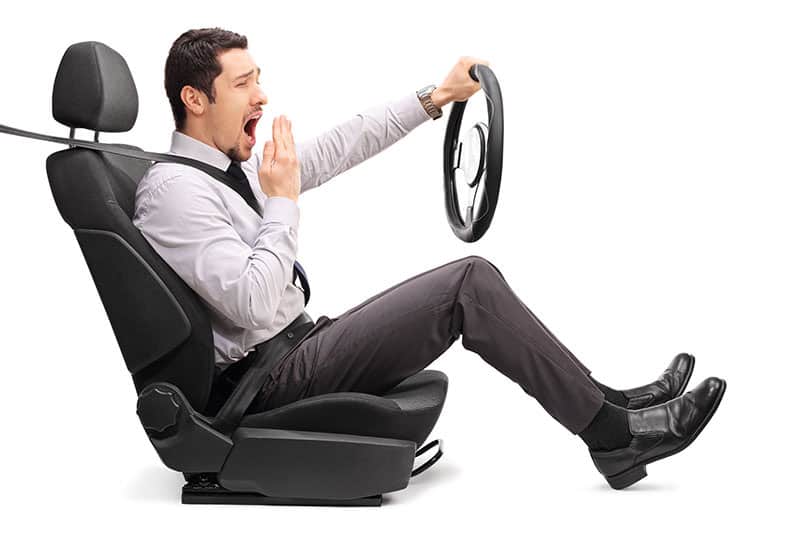Drowsy driving is another term for sleep deprived driving. Generally, drowsy driving refers to being impaired while driving due to sleep deprivation or fatigue.
Is Drowsy Driving a Serious Problem?
People are often aware that drinking and driving is very dangerous. However, other types of distracted driving can be just as deadly as drunk driving. The statistics that concern drowsy driving are alarming. According to Triple AAA, twenty-one percent of fatal crashes involve a drowsy driver.
Drowsy driving is a problem all over the world. Countries such as Australia and Finland have reported that drowsy driving accidents account for at least ten percent of all crashes.
What are the Effects of Drowsy Driving?
There are several consequences to attempting to drive while drowsy.
Operating a vehicle while drowsy has similar effects to operating a vehicle while intoxicated. One of the biggest similarities between these two types of distracted driving is the delayed reaction time.
Motorists have a slower reaction time when they attempt to drive while they are drowsy. The average reaction time varies from person to person, but the average reaction time is about .5 seconds. This may not seem like a long time, but a motorist that is driving seventy miles per hour can travel forty feet during the time it takes them to react.
This means that the driver could be unable to respond quick enough to prevent an accident. For more information about reaction time visit: https://www.howacarworks.com/advanced-driving/reaction-times.
People who drive while they are drowsy also suffer from problems with judgment and vision. Another consequence of drowsy driving is increased aggressive behaviors on the road. For example, people who are drowsy often drive in a more dangerous manner.
Drowsy driving can create financial liability if a person falls asleep behind a wheel. For example, a victim of drowsy driving can sue the drowsy driver for negligence. Many states also have criminal liability for those that kill or injure someone because of drowsy driving.
Who is at risk for Drowsy Driving?
There are certain groups of people that are at a greater risk for distracted driving. The National Sleep Foundation has provided a summary of the groups that are more prone to drive while they are drowsy.
- Men are more likely than women to drive while they are drowsy, and men are more likely to fall asleep behind the wheel than women are.
- Adults between the ages of 18-29 are more likely to drive while they are drowsy. Some studies show that people in the older age groups are more likely than those in the younger age group to pull over and take a nap if they get tired behind the wheel.
- Shift workers are at a greater risk of drowsy driving than others.
- Adults who have children are more likely to drive while drowsy.
- Obviously, people who do not get enough sleep are at a greater risk of drowsy driving. People who get less than five hours of sleep a night are nearly five times as likely to get into an accident due to drowsy driving than those who get eight hours of sleep. Another group of people that is at risk for drowsy driving are those who have sleep disorders.
- Individuals who take certain medications may be at risk for drowsy driving. It is important to consult with your doctor about the possible side effects of your medication in order to ensure that you are not at risk for drowsy driving.
- The location of the drivers can also influence how likely someone is to fall asleep while driving. For example, people who are driving on rural highways are more likely to drive while they are drowsy than those who are driving in the city.
While the statistics point to these groups, being more prone to drowsy driving it is important to remember that anyone can make the mistake of getting behind the wheel when they have not had enough sleep.
What can be done about Drowsy Driving?
One of the easiest things that can be done is education. As discussed above, many people are not aware that drowsy driving is serious. Change can start with a single individual. If you are drowsy, stop what you are doing. This could save your life.
Some victims of drowsy driving are asking people to take a pledge to stay alert. You can find more information about one women’s quest to find closure by encouraging others to never drive while they are drowsy at http://www.kens5.com/news/local/widow-speaks-out-during-drowsy-driving-awareness-week/349391673.
Some truck companies are taking steps to limit the amount of drowsy driving that occurs. To accomplish these goals trucking companies are attempting to find a balance between meeting their bottom line and ensuring that employees are operating their trucks in a safe manner.
Obviously trucking companies want to make a profit. The only way these companies can make a profit is to have truck drivers deliver loads. However, at the same time trucking companies realize that truck drivers can be at risk for drowsy driving.
These companies are creating comprehensive policies that provide training for truckers and help identify sleeping disorders. Hopefully, that more companies will continue to fight against drowsy driving.
Conclusion
Triple AAA reports that thirty-seven percent of drivers have admitted to falling asleep behind the wheel. This statistic is alarming and indicates that many people do not know how dangerous drowsy driving can be.
One important thing to remember is that distracted driving is one hundred percent preventable. Drivers can make smart choices every day that can limit the amount of accidents that occur.
When we get behind the wheel, we need to remember that we have a responsibility to focus on the task at hand. The National Sleep Foundation’s motto says it best: “Stay Alert, Arrive Alive.â€
This motto can apply to all types of distracted driving, but people often forget that drowsy driving is just as serious as other types of distracted driving. It is important to get enough sleep before you get behind the wheel. Your life could be at stake.














